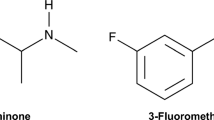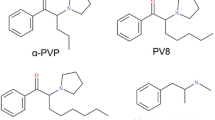Abstract
Both LSD and apomorphine produced hyperactivity in reserpine-treated mice, LSD being more potent and longer-acting than apomorphine. 2-Brom LSD and the serotonin (5-HT) receptor agonist quipazine were ineffective in reversing reserpine sedation. Treatments with phenoxybenzamine and methysergide failed to block the stimulant effects of either LSD or apomorphine, demonstrating the noninvolvement of 5-HT or norepinephrine (NE) receptors in their action. The ineffectiveness of α-methyl-p-tyrosine in modifying the stimulant effects of LSD and apomorphine indicated a probable direct stimulant effect of these two drugs on the dopamine (DA) receptors. Low doses of chlorpromazine, haloperidol, or pimozide blocked the effects of apomorphine in reserpinized mice. Although these neuroleptics significantly reduced the effects of LSD, they failed to block completely the LSD effects even at higher doses. Apomorphine reduced the α-methyl-p-tyrosine-induced depletion of DA in the whole brain of mice, but LSD failed to do so. From these findings it is postulated that apomorphine acts as a direct DA receptor agonist, and that LSD may act directly on a site structurally closely related to DA receptor, but not necessarily identical with it. Repeated treatments with LSD did not lead to development of tolerance to its locomotor effects in reserpinized mice. Moreover, mescaline and psilocybin, which are known to exhibit cross-tolerance to LSD, failed to produce LSD-like effects in reserpine-treated mice. The effects of LSD on the DA or a related site probably are not solely responsible for its psychotomimetic effects.
Similar content being viewed by others
References
Abramson, H. A., Jarvik, M. E., Gorin, M. H., Hirsch, M. W.: LSD tolerance development and its relation to a theory of psychosis. J. Psychol. 41, 81–105 (1956)
Aghajanian, G. K., Haigler, H. J.: Mode of action of LSD on serotoninergic neurons. Advanc. Biochem. Psychopharmacol 10, 167–177 (1974)
Andén, N.-E., Corrodi, H., Fuxe, F., Hökfelt, T.: Evidence for a central 5-hydroxytryptamine receptor stimulation by lysergic acid diethylamide. Brit. J. Pharmacol. 34, 1–7 (1968)
Andén, N.-E., Corrodi, H., Fuxe, K.: Effect of neuroleptic drugs on central catecholamine turnover assessed using tyrosine and dopamine-β-hydroxylase inhibitors. J. Pharm. Pharmacol. 24, 177–182 (1972)
Andén, N.-E., Corrodi, H., Fuxe, K., Hökfelt, T., Rydin, C., Svensson, T.: Evidence for a central noradrenaline receptor stimulation by clonidine. Life Sci. 9, 513–523 (1970)
Andén, N.-E., Rubensson, A., Fuxe, F., Hökfelt, T.: Evidence for dopamine stimulation by apomorphine. J. Pharm. Pharmacol. 19, 627–629 (1967)
Balestrieri, A., Fontanari, D.: Acquired and crossed tolerance to mescaline, LSD-125 and BOL-148. Arch. gen. Psychiat. 1, 279–282 (1959)
Benešová, O., Beneš, V.: Experimental study on the mechanism of depressogenic action of apomorphine and reserpine. Activ. nerv. sup. (Praha) 14, 269–272 (1972)
Bogdanski, D. F., Spector, S.: Comparison of central actions of cocaine and LSD. Fed. Proc. 16, 284 (1957)
Brodie, B. B., Olin, J. S., Kuntzman, R., Shore, P. A.: Possible interrelationship between release of brain norepinephrine and serotonin by reserpine. Science 125, 1293 (1957)
Brodie, B. B., Spector, S., Shore, P. A.: Interaction of drugs with norepinephrine in the brain. Pharmacol. Rev. 11, 548–566 (1959)
Butterworth, R. F., Poignant, J. C., Barbeau, A.: Apomorphine and piribidil in rats: Biochemical and pharmacological studies. Advanc. Neurol. 9, 307–326 (1975)
Carlsson, A., Lundqvist, M., Magnusson, T.: 3,4-Dihydroxyphenylalanine and 5-hydroxytryptophan as reserpine antagonists. Nature (Lond.) 180, 1200 (1957)
Carlsson, A., Lindqvist, M., Magnusson, T. Waldeck, B.: On the presence of 3-hydroxytyramine in brain. Science 127, 471 (1958)
Cerletti, A., Rothlin, E.: Role of 5-hydroxytryptamine in mental diseases and its antagonism to lysergic acid derivatives. Nature (Lond.) 176, 785–786 (1955)
Cheramy, A., Besson, M. J., Glowinsky, J.: Increased release of dopamine from striatal dopaminergic terminals in the rat after treatment with a neuroleptic: Thioproperazine. Europ. J. Pharmacol. 10, 206–214 (1970)
Cholden, L. S., Kwiland, A., Savage, C.: Clinical reaction and tolerance to LSD in chronic schizophrenia. J. nerv. ment. Dis. 122, 211–221 (1955)
Corrodi, H., Fuxe, K., Ungerstedt, U.: Evidence for a new type of dopamine receptor stimulating agent. J. Pharm. Pharmacol. 23, 989–991 (1971)
Costa, E., Gessa, G. L., Kuntzman, R., Brodie, B. B.: The effects of drugs on storage and release of serotonin and catecholamine in brain. Proc. 1st Int. Pharmacol. Meet., vol. 8, pp. 43–74. New York: Macmillan 1962
Costall, B., Naylor, R. J.: The role of the raphé and extrapyramidal nuclei in the stereotyped and circling response to quipazine. J. Pharm. Pharmacol. 27, 368–371 (1975)
Da Prada, M., Saners, S., Burkard, W. P., Bartholini, G., Pletscher A.: Lysergic acid diethylamide: Evidence for stimulation of cerebral dopamine receptors. Brain Res. 94, 67–73 (1975)
Dixon, A. K.: Evidence of catecholamine mediation in the ‘aberrant’ behavior induced by lysergic acid diethylamide. Experientia (Basel) 24, 743–747 (1968)
Elder, J. T., Dille, J. M.: An experimental study of the participation of the sympathetic nervous system in the lysergic acid diethylamide (LSD) reaction in rats. J. Pharmacol. exp. Ther. 136, 162–168 (1962)
Ernst, A. M.: Mode of action of apomorphine and dexamphetamine on gnawing compulsion in rats. Psychopharmacologia (Berl.) 10, 316–323 (1967)
Fleming, R. M., Clark, W. G., Fenster, E. D., Towne, J. C.: Single extraction method for the simultaneous fluorometric determination of serotonin, dopamine and norepinephrine in brain. Analyt. Chem. 37, 692–696 (1965)
Freedman, D. X.: LSD-25 and brain serotonin in reserpinized mice. Fed. Proc. 19, 266 (1960)
Freedman, D. X., Aghajanian, G. K., Ornitz, E. M., Rosner, B. S.: Patterns of tolerance to lysergic acid and mescaline in rats. Science 127, 1173–1174 (1958)
Fuxe, K., Agnati, L. F., Corrodi, H., Everitt, B. J., Hökfelt, T.: Löfström, A., Ungerstedt, U.: Action of dopamine receptor agonists in forebrain and hypothalamus: Rotational behavior, ovulation and dopamine turnover. Advanc. Neurol. 9, 223–242 (1975)
Gaddum, J. H.: Antagonism between lysergic acid diethylamide and 5-hydroxytryptamine. J. Physiol. (Lond.) 121, 15P (1953)
Gaddum, J. H., Hameed, K. A.: Drugs which antagonize 5-hydroxytryptamine. Brit. J. Pharmacol. 9, 240–248 (1954)
Gogerty, J. H., Dille, J. M.: Tolerance to the pyretogenic effects of lysergic acid diethylamide. J. Pharmacol. exp. Ther. 116, 450–452 (1956)
Grabowska, M., Antkiewicz, L., Michaluk, J.: The influence of quipazine on the turnover rate of serotonin. Biochem. Pharmacol. 23, 3211–3222 (1974)
Himwich, H. E.: In: Discussion. Third Symposium Neuro-psychopharmacology. P. B. Bradley, P. Deniker, and C. Radonco-Thomas, eds. pp. 129–133. Amsterdam: Elsevier 1959
Holzbauer, M., Vogt, M.: Depression by reserpine of the noradrenaline concentration in the hypothalamus. J. Neurochem. 1, 8–11 (1956)
Isbell, H., Fraser, H. F., Wikler, A., Belleville, R. E.: Tolerance of diethylamide of lysergic acid. Fed. Proc. 14, 354 (1955)
Isbell, H., Logan, C. R.: Studies on the diethylamide of lysergic acid (LSD-25). II. Effects of chlorpromazine, azacyclonol and reserpine on the intensity of the LSD reaction. Arch. Neurol. Psychiat. (Chic.) 77, 350–358 (1957)
Isbell, H., Miner, E. J., Logan, C. R.: Relationship of psychotomimetic antiserotonin potencies of congeners of lysergic acid diethylamide (LSD-25) Psychopharmacologia (Berl.) 1, 20–28 (1959)
Isbell, H., Wolbach, A. B., Wikler, A., Miner, E. J.: Cross tolerance between LSD and psilocybin. Psychopharmacologia (Berl.) 2, 147–159 (1961)
Janssen, P. A. J., Niemegeers, C. J. E., Schiellekens, K. H. L.: Is it possible to predict the clinical effects of neuroleptic drugs (major tranquilizers) from animal data ? Part I. Arzneimittel-Forsch. 15, 104–117 (1965)
Kelly, P. H.: Action of LSD on supersensitive mesolimbic receptors. Brit. J. Pharmacol. 55, 291P (1975)
Klawans, H. L., Jr., Weiner, W. J.: Animal models of human extrapyramidal disorders. In: Models of Human Neurological Diseases, H. L. Klawans, Jr. ed., pp. 1–38. Amsterdam: Excerpta Medica 1974
Lal, S., Sourkes, T. L., Missala, K., Belendiuk, G.: Effects of aporphine and emetine alkaloids on central dopaminergic mechanisms in rats. Europ. J. Pharmacol. 20, 71–79 (1972)
Laverty, R., Taylor, K. M.: The fluorometric assay of catecholamines and related compounds: Improvements and extensions to the hydroxyindole techniques. Analyt. Biochem. 22, 269–279 (1968)
Maj, J., Sowinska, H., Baran, L., Kapturkiewicz, Z.: The effect of clonidine on locomotor activity in mice. Life Sci. 11, 483–491 (1972)
McKenzie, G. M.: Apomorphine-induced aggression in the rat. Brain Res. 34, 323–330 (1971)
Medon, P. J., Leeling, J. L., Phillips, B. M.: Influence of quipazine, a potential antiparkinsonian agent, on the uptake of 3H-dopamine, and 3H-serotonin into rat striatal tissue in vitro. Life Sci. 13, 685–691 (1973)
Pieri, L., Pieri, M., Haefely, W.: LSD as an agonist of dopamine receptors in the striatum. Nature (Lond.) 252, 586–588 (1974)
Rodriguez, R., Pardo, E. G.: Quipazine, a new type of antidepressant agent. Psychopharmacologia (Berl.) 21, 89–100 (1971)
Roos, B.-E.: Decrease in homovanillic acid as evidence for dopamine receptor stimulation by apomorphine in the neostriatum of the rat. J. Pharm. Pharmacol. 21, 263–264 (1969)
Rothlin, E.: Pharmacology of lysergic acid diethylamide and some of its related compounds. J. Pharm. Pharmacol 9, 569–587 (1957)
Shore, P. A., Silver, S. L., Brodie, B. B.: Interaction of reserpine, serotonin and lysergic acid diethylamide in brain. Science 122, 284–285 (1955)
Spano, P. F., Kumakura, K., Tonon, G. C., Giovoni, S., Trabucci, M.: LSD and dopamine-sensitive adenylate cyclase in various rat brain areas. Brain Res. 93, 166–167 (1975)
Taeschler, M., Cerletti, A.: Some observations on the interaction of reserpine and LSD. J. Pharmacol. exp. Ther. 120, 179–183 (1957)
Ungerstedt, U., Avemo, A., Avemo, E., Ljungbert, T., Range, C.: Animal models of Parkinosonism. Advanc. Neurol. 3, 257–271 (1973)
Von Hungen, K., Roberts, S., Hill, D. F.: Interactions between lysergic acid diethylamide and dopamine-sensitive adenylate cyclase systems in rat brain. Brain Res. 94, 57–66 (1975)
Votava, Z., Glisson, S. N. Himwich, H. E.: Behavioral reaction of rats pretreated with reserpine to LSD-25. Int. J. Neuropharmacol. 6, 543–547 (1967)
Weiner, W. J., Goetz, C., Klawans, H. L.: Serotoninergic and antiserotoninergic influences of apomorphine-induced stereotyped behavior. Acta pharmacol. (Kbh.) 36, 155–160 (1975)
Winter, J. C.: Tolerance to a behavioral effect of lysergic acid disthylamide and cross tolerance to mescaline in the rat: Absence of a metabolic component. J. Pharmacol. exp. Ther. 178, 625–630 (1971)
Winter, C. H., Flataker, L.: Effects of lysergic acid diethylamide upon performance of trained rats. Proc. Soc. exp. Biol. (N.Y.) 92, 285–289 (1956)
Woolley, D. W., Shaw, E.: A biochemical and pharmacological suggestion about certain mental disorders. Proc. nat. Acad. Sci. (Wash.) 40, 228–231 (1954)
Author information
Authors and Affiliations
Rights and permissions
About this article
Cite this article
Menon, M.K., Clark, W.G. & Masuoka, D.T. Possible involvement of the central dopaminergic system in the antireserpine effect of LSD. Psychopharmacology 52, 291–297 (1977). https://doi.org/10.1007/BF00426714
Received:
Accepted:
Issue Date:
DOI: https://doi.org/10.1007/BF00426714




